My recent post on LinkedIn about heading back to India as a venture capitalist after almost 15 years in the US made me realise just how many people in my network have been mulling on this broader topic: moving back to their respective home countries from their current country of residence for various reasons, ranging from doing a startup to joining a big firm.
Returning to India had far too many aspects to consider: family, career path, day-to-day, salary, lifestyle, and overall happiness. What really helped me decide to make the jump was a set of frameworks I went through in evaluating the top three factors in this decision:
- Why am I moving to India?
- When is the right time to move?
- What should I do in India that is 10x of what I could do in the US?
The “where do I die” framework
If you are like me and have lived or worked in multiple countries and traveled quite extensively, it is likely that you love a lot of places. When thinking about where I wanted to be long-term, I was always asking myself, “where do I want to live” and it was impossible to make up my mind this way. The right question was “where do I want to die.” There was no confusion about that question.

The moment I knew the answer to that question in my heart, the next question was, “how far back do I walk from, well, death?” Do I wait until retirement? Until I hit 40? Or should I go now? Which brings me to the second framework.
The “when is the right time” framework
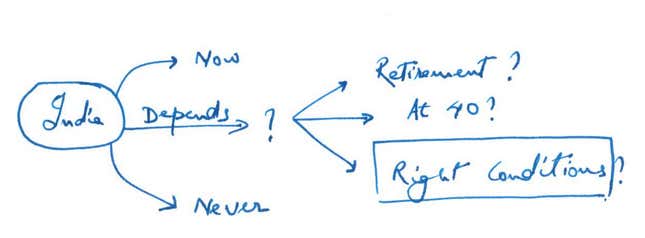
This is mostly self-explanatory. Personally, for me, the “now” option seemed impulsive—only to be taken if there is a family urgency or if the option is forced upon you (e.g. visa complications). The “never” option often is about having too deep a root in the your current country of residence — a partner disinterested in moving, kids, health needs, etc. I luckily had no such constraints so I could focus on creating the right conditions under which the move back to India would have the maximum chances of success.
To arrive at the “right condition” step, however, we need to back up a little to what I call the “career gap analysis” framework. It’s one of the more useful frameworks I’ve used and if you are honest and consistent in your efforts, it works.
The “career gap” framework
Career is a long game. I’ve thought of my career as an XY graph where, at time t=0, I am at the bottom left and trying to move to the top right. For this to work, you need to know what the top-right is. Take a few samples below:
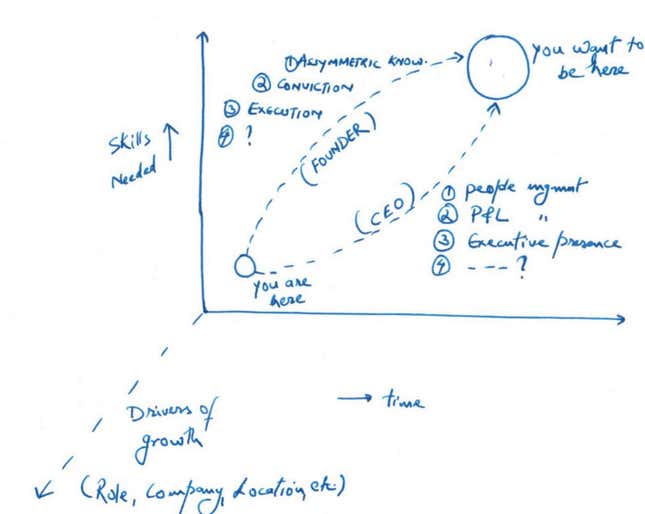
Think through where you are today and where you want to be five years from now. For example, if you want to start up you need to build a “superpower”—something only you can bring to the table in tech prowess, market understanding, or connections. You also need to build conviction and passion for an idea to survive the hard times, and you have to be an execution machine, among other things. Start working on those.
But how? Enter: the z-axis.
I think of the z-axis as a driver for step-function improvement on the y-axis. It’s really difficult to grow (and grow fast) until you put yourself outside of your comfort zone. What brings about this discomfort is a movement on the z-axis—the drivers of growth—for example, a new role within the same company, furthering your education, changing your company, changing location, etc.
Taking my career as an example:
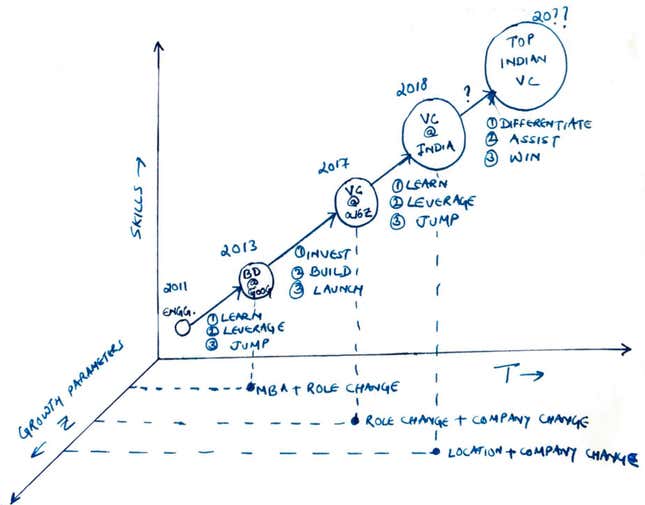
I was an engineer right out of college, but after six-plus years of writing code, I wanted a more business-centric profile. I shifted into a product manager role within my firm (role change), followed by an MBA (education), after which I joined Google Cloud in a strategic business development role. A few years in, I got curious about investing and also started orchestrating a move to India. While at Google I helped out during deal diligence for GV and CapitalG and also participated or led a few investments for Google until I joined a well-known venture-capital firm, Andreessen Horowitz (company change), and eventually found an opportunity to move to India (location change) as an investor.
With that, we can now move on to:
The “right conditions” framework
So far, you’ve understood: where you want to move, when you want to move, and how to think about a long-term career roadmap which will inform the right conditions for a move.
Let’s take an example of a founder in the US who wants to move to India to build an India-focused company. The conditions she might care most about—assuming there is just no personal angle to her decision—are: can she build a product that Indians will use/buy; does she have the right network to build a solid consumer/enterprise product team in India, and does she have the right connections to raise capital in India.
These conditions are weighted below as per her preferences, that is, skewed completely towards the professional.
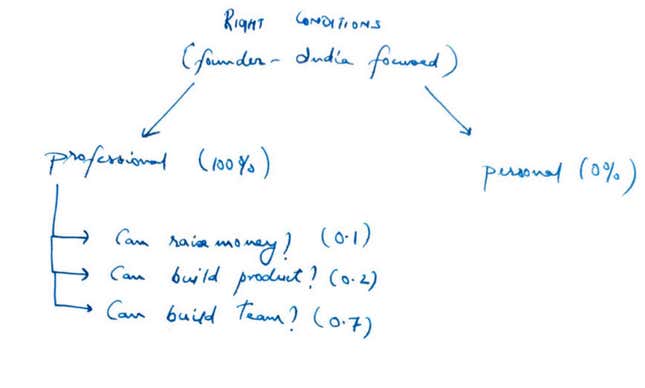
The trick here is to really understand what you are moving back for and then being extra flexible on everything else.
For me it was 60% personal, 40% professional, and my evaluation matrix took those weights under consideration.
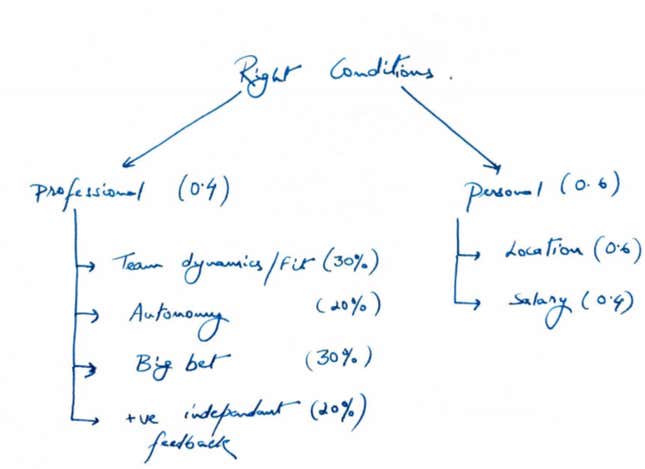
Professionally, fit with the team was paramount, followed by how much autonomy I will get in the new role, whether this is a team that’s thinking big and is betting their careers on, and what my trusted sources say about the firm. Personally, the jump had to satisfy a certain salary minimum and a location close to my family.
Note that you will get stuck at this stage if you set too high a score for yourself or are not honest about your reasons for the move. Also note that the framework still works if, say, you have to move back because your family needs you urgently—your evaluation matrix simply puts most of its weight on the personal in that case.
Once you have done this exercise, you can move to the fifth and final framework: the opportunity evaluation matrix.
The “opportunity evaluation” framework
If you have gotten this far, congratulations: You have multiple roles on the table and you now need to stack-rank them based on your conditions to make the jump. At this point, you know where to jump to (framework No.1), when to jump (framework No.2), how does this fits into the bigger picture (framework No.3), and what criteria are needed to pull the trigger (framework No.4). The evaluation matrix framework helps you pick one of the multiple options you may have in front of you.
Here’s a hypothetical example below to help you think through it. All you need now is a weighted average score per role. For the example below, for job#1, the way you find the total score is:
professional-weight *{(fit-score * 0.3) + (autonomy-score * 0.2) + …} + personal-weight * {(location-score * 0.6) + (salary-score * 0.4)}
So that’s [ 0.4 * (10*0.3 + 8*0.2 + …) + 0.6 * (10*0.6 + 9*0.4) ] = 8.24
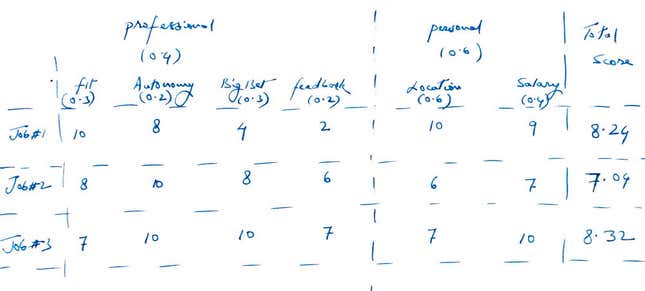
At the end of this exercise, you need to do a gut check. Once you learn which job won, evaluate whether you feel excited or surprised or disappointed.
In the above example, job No.3 wins, but by a small margin over job No.1. Job No.3 probably means you won’t be as close to your family as you want, but this role has more autonomy, a little better salary, and is going after a far bigger bet. If you still feel jittery about your call, you have probably not been honest about your criteria or the weights.
India is an incredible growth story that’s still early in the making and being there now is going to be invigorating, satisfying, but also frustrating if you haven’t thought through the whys and the whens properly. I hope these frameworks can help you understand objectively your path for the next few years and, if you are an Indian living abroad, I hope that path leads you back to India!
Follow Hemant on Twitter @mohapatrahemant.
This post first appeared on Medium. We welcome your comments at ideas.india@qz.com.
